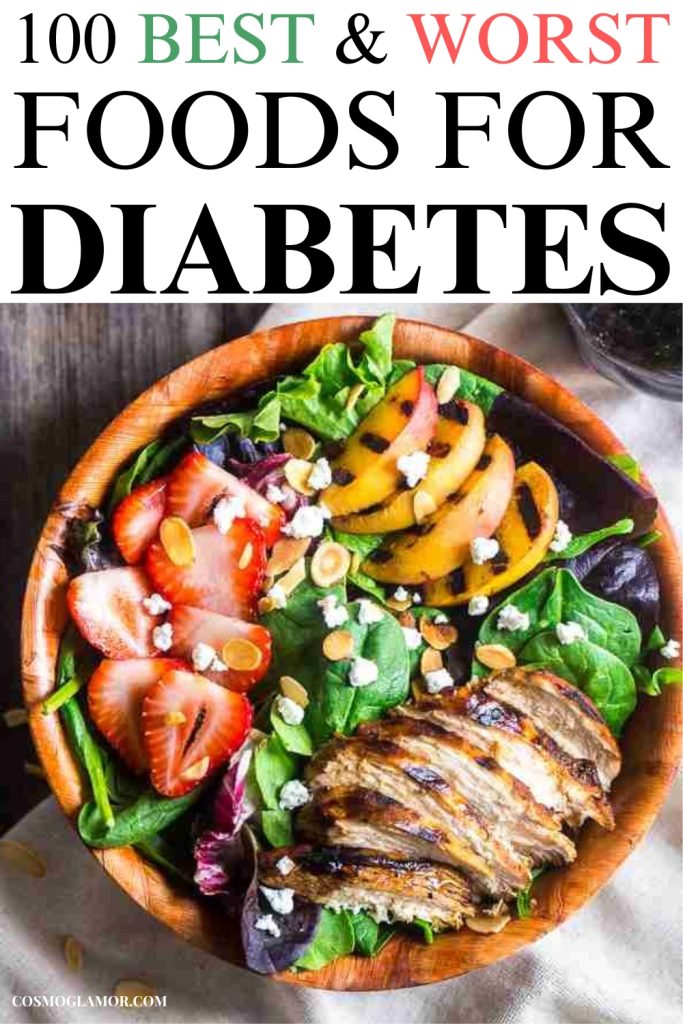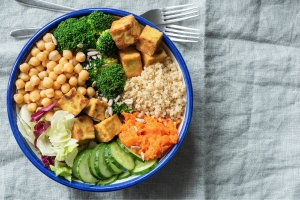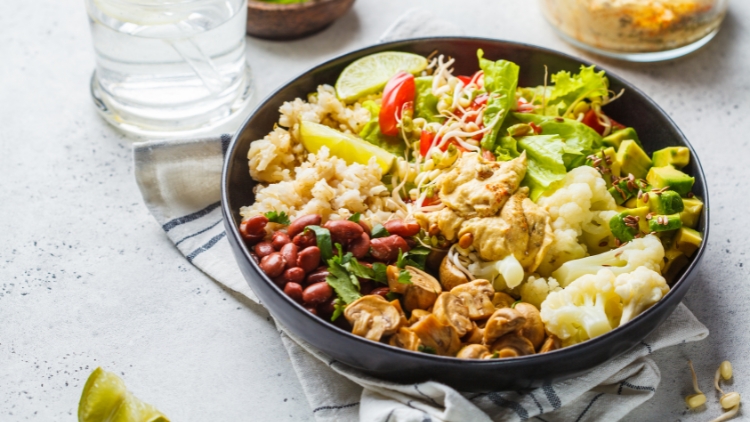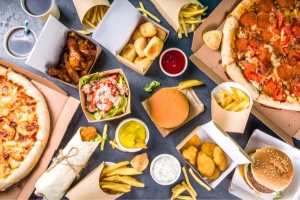So, you’ve been diagnosed with diabetes, or you’re helping someone who has. Welcome! It’s a journey that requires understanding and adaptation, but it absolutely does not mean a life sentence of boring, tasteless food. In fact, eating well with diabetes can be surprisingly delicious and satisfying.
My own journey started with a rather concerning blood test and a doctor who, let’s just say, strongly encouraged some dietary changes. The initial feeling was, frankly, overwhelming. I felt like I needed a PhD in nutrition just to figure out what I could and couldn’t eat.
But here’s the key takeaway I learned (after a few missteps, of course): it’s not about striving for impossible perfection – it’s about making informed, healthy choices that work for your individual needs and lifestyle. It’s about progress, not perfection.
Rethinking “Diet”: Embrace a Sustainable Lifestyle

Let’s ditch the restrictive “diet” mentality. We’re talking about a shift in your approach to food, a way of eating that’s both nourishing and enjoyable. Think of it as upgrading your fuel, not restricting your options.
The core principle is beautifully simple: prioritize whole, unprocessed foods. Foods in their most natural state are generally your best allies.
The “Yes!” List: Your Nutritional Powerhouses
This section provides an extensive list of foods that are generally beneficial for people with diabetes. Remember to always consider portion sizes, even with healthy foods.
Non-Starchy Vegetables: Fill Half Your Plate!

These are your foundational foods. They’re low in carbohydrates, rich in vitamins, minerals, and fiber, and have a minimal impact on blood sugar.
-
Leafy Greens: Spinach, Kale, Romaine Lettuce, Collard Greens, Mustard Greens, Turnip Greens, Bok Choy, Swiss Chard, Arugula, Endive, Watercress.
-
Cruciferous Vegetables: Broccoli, Cauliflower, Brussels Sprouts, Cabbage (green, red, Savoy), Kohlrabi.
-
Other Non-Starchy Vegetables: Asparagus, Artichokes, Green Beans, Wax Beans, Snap Peas, Snow Peas, Mushrooms (all varieties), Onions, Garlic, Leeks, Shallots, Celery, Cucumbers, Zucchini, Summer Squash, Eggplant, Bell Peppers (all colors), Jalapeño Peppers, Tomatillos, Okra, Radishes, Turnips, Jicama.
Fruits (in Moderation, Choose Whole Fruit):

While fruits contain natural sugars (fructose), they also provide essential vitamins, minerals, and fiber. Prioritize whole fruits over fruit juices, and be mindful of portion sizes.
-
Berries (Excellent Choice): Blueberries (¾ cup), Strawberries (¾ cup), Raspberries (¾ cup), Blackberries (¾ cup).
-
Other Good Choices: Apples (1 small), Pears (1 medium), Oranges (1 medium), Grapefruit (½), Peaches (1 medium), Plums (2 small), Cherries (¾ cup), Kiwi (1-2), Apricots (2-3).
Lean Proteins: Essential for Satiety and Muscle Health:

Protein helps keep you feeling full and satisfied, and it has a minimal impact on blood sugar levels. Choose lean sources to minimize saturated fat intake.
-
Poultry (Skinless): Chicken Breast, Turkey Breast, Ground Chicken (lean), Ground Turkey (lean).
-
Fish (Especially Fatty Fish): Salmon, Mackerel, Tuna (fresh or canned in water), Sardines, Herring, Trout, Cod, Haddock, Halibut.
-
Lean Beef (Choose “Loin” or “Round”): Sirloin, Tenderloin, Round Steak, Ground Beef (90% lean or higher).
-
Pork (Lean Cuts): Pork Tenderloin, Pork Chops (center cut, lean).
-
Eggs: Whole Eggs (including the yolk, which contains valuable nutrients).
-
Plant-Based Proteins:
- Legumes: Lentils (all varieties), Chickpeas (Garbanzo Beans), Black Beans, Kidney Beans, Pinto Beans, Navy Beans, Soybeans (Edamame).
- Tofu and Tempeh: Made from soybeans, these are versatile protein sources.
- Nuts and Seeds (in Moderation): Almonds (¼ cup), Walnuts (¼ cup), Pecans (¼ cup), Cashews (¼ cup), Pumpkin Seeds (¼ cup), Sunflower Seeds (¼ cup), Chia Seeds (2 tablespoons), Flax Seeds (2 tablespoons), Hemp Seeds (2 tablespoons).
Whole Grains: Choose Wisely Over Refined Grains:

Whole grains provide more fiber, vitamins, and minerals than refined grains, leading to a slower, more gradual rise in blood sugar.
-
Excellent Choices: Quinoa, Brown Rice, Wild Rice, Oats (Steel-Cut or Rolled), Barley, Bulgur, Farro.
-
Other Whole Grains (Check Labels Carefully): Whole Wheat Bread (ensure the first ingredient is “whole wheat”), Whole Wheat Pasta, Whole Grain Cereals (look for high fiber and low added sugar).
Healthy Fats: Important for Heart Health and Satiety:

Healthy fats are essential for overall health and can help keep you feeling full. However, all fats are calorie-dense, so moderation is crucial.
-
Avocados: (¼ to ½ of a medium avocado).
-
Nuts and Seeds: (See list under Plant-Based Proteins).
-
Oils: Olive Oil, Avocado Oil, Canola Oil (in moderation).
-
Fatty Fish: (See list under Fish).
Dairy and Dairy Alternatives (Choose Low-Fat or Nonfat):

Opt for low-fat or nonfat versions to reduce saturated fat intake, and always choose unsweetened varieties.
-
Yogurt: Plain, Nonfat Greek Yogurt, Plain, Low-Fat Yogurt.
-
Milk: Nonfat Milk, Low-Fat Milk.
-
Plant-Based Alternatives (Unsweetened): Almond Milk, Soy Milk, Oat Milk, Cashew Milk, Flax Milk, Hemp Milk.
-
Cheese: Cottage Cheese (low-fat).
The “Proceed with Caution” List: Foods to Limit or Avoid
This section lists foods that can negatively impact blood sugar control and overall health, particularly for people with diabetes.
Sugary Drinks: High in Simple Sugars, Low in Nutrients

- Regular Soda: All varieties.
- Fruit Juice: Even 100% fruit juice, due to the lack of fiber.
- Sweetened Tea: Iced tea, bottled tea with added sugar.
- Energy Drinks: Often contain high levels of sugar and caffeine.
- Sports Drinks: Designed for intense athletic activity, not for daily consumption.
- Coffee Drinks: Loaded with sugar and cream.
Refined Grains: Lacking Fiber and Nutrients

- White Bread: Including bagels, rolls, and croissants.
- White Rice: All varieties.
- Pasta (Made with White Flour): Most commercially available pasta.
- Breakfast Cereals (Low in Fiber, High in Sugar): Many popular brands.
Processed Foods: Often High in Sugar, Unhealthy Fats, and Sodium

- Packaged Snacks: Chips, crackers, cookies, pastries.
- Frozen Meals: Many are high in sodium and unhealthy fats.
- Processed Meats: Bacon, sausage, hot dogs, deli meats (often high in sodium and nitrates).
- Fast Food: Generally high in calories, unhealthy fats, and sodium.
Fried Foods: High in Unhealthy Fats and Calories

- French Fries: And other deep-fried potato products.
- Fried Chicken: And other fried meats.
- Doughnuts: And other fried pastries.
- Tempura: Even vegetable tempura can be high in calories and fat.
Alcohol: Requires Careful Consideration and Doctor Consultation

- All Alcoholic Beverages: Beer, wine, spirits. Alcohol can interact with diabetes medications and cause unpredictable blood sugar fluctuations. Always consult your doctor about safe alcohol consumption.
Portion Control: Your Key to Success

Even the healthiest foods can contribute to weight gain and blood sugar spikes if eaten in excessive amounts. Mastering portion control is absolutely essential.
-
The Plate Method: A simple, visual guide:
- ½ Plate: Non-starchy vegetables.
- ¼ Plate: Lean protein.
- ¼ Plate: Whole grains or starchy vegetables.
-
Handy Portion Guide: Use your hand as a rough estimate:
- Palm: Protein (about 3 oz).
- Fist: Cooked grains or starchy vegetables (about 1 cup).
- Cupped Hand: Fruit (about ½ cup).
- Two Cupped Hands: Non-starchy vegetables (about 1-2 cups)
- Thumb: Fats (about 1 Tablespoon of oil or 2 Tablespoons of nuts).
-
Measure It Out: Especially when starting, using measuring cups and spoons can help you get a much better sense of appropriate portion sizes.
Meal Timing: Consistency is Key

Eating regular meals at consistent times helps regulate your blood sugar levels. Aim for three meals a day, spaced roughly 4-5 hours apart. Don’t skip breakfast! It helps kickstart your metabolism and can prevent overeating later.
Glycemic Index (GI) and Glycemic Load (GL): Useful Concepts (But Don’t Get Lost in the Details)

Let’s dive a little deeper into the Glycemic Index (GI) and Glycemic Load (GL). These are tools that can help you understand how different carbohydrate-containing foods affect your blood sugar levels. While they’re useful, remember the core principles we’ve already discussed: prioritizing whole, unprocessed foods, practicing portion control, and eating regular meals are still your most important strategies.
What is the Glycemic Index (GI)?
The GI is a ranking system that measures how quickly a carbohydrate-containing food raises blood sugar levels compared to pure glucose (which has a GI of 100). Foods are ranked on a scale of 0 to 100:
- Low GI: 55 or less (These foods cause a slower, more gradual rise in blood sugar.)
- Medium GI: 56-69
- High GI: 70 or more (These foods cause a rapid spike in blood sugar.)
The GI only applies to foods that contain carbohydrates. Foods like meat, fish, and pure fats don’t have a GI value because they don’t contain significant amounts of carbohydrates.
What is the Glycemic Load (GL)?
The GL takes the GI a step further. It considers both the GI of a food and the amount of carbohydrates in a typical serving. This makes it a more practical measure for understanding the real-world impact of a food on your blood sugar.
The GL is calculated using this formula:
GL = (GI x Carbohydrates (grams) per serving) / 100
GL values are categorized as follows:
- Low GL: 10 or less
- Medium GL: 11-19
- High GL: 20 or more
Why are GI and GL Useful?
Choosing foods with a lower GI and GL can help you:
- Achieve more stable blood sugar levels.
- Improve insulin sensitivity.
- Feel fuller for longer (which can help with weight management).
- Reduce the risk of long-term diabetes complications.
Important Considerations:
- GI and GL are not perfect. The GI of a food can be affected by factors like ripeness, cooking method, and even the other foods you eat with it. For example, eating a high-GI food with protein and healthy fats can help slow down its absorption and reduce its impact on your blood sugar.
- Focus on the overall quality of your diet. A low-GI diet that’s still high in processed foods and unhealthy fats is not going to be beneficial.
- Individual responses can vary. Some people are more sensitive to the effects of high-GI foods than others.
Common Foods: GI and GL Values
Here’s a table of common foods with their approximate GI and GL values. Remember, these are estimates, and values can vary. The serving sizes used are typical portions.
| Food | GI (Approximate) | Serving Size | Carbohydrates (g) | GL (Approximate) | Category |
| Grains | |||||
| White Bread | 75 | 1 slice (30g) | 15 | 11 | High GI/Med GL |
| Whole Wheat Bread (100%) | 53 | 1 slice (30g) | 12 | 6 | Low GI/Low GL |
| White Rice (boiled) | 73 | 1 cup (150g) | 45 | 33 | High GI/High GL |
| Brown Rice (boiled) | 50 | 1 cup (150g) | 45 | 23 | Low GI/High GL |
| Quinoa (cooked) | 53 | 1 cup (185g) | 39 | 21 | Low GI/High GL |
| Oatmeal (rolled, cooked) | 55 | 1 cup (234g) | 28 | 15 | Low GI/Med GL |
| Barley (pearled, cooked) | 28 | 1 cup(157g) | 44g | 12 | Low GI/Med GL |
| Bulgur (Cooked) | 48 | 1 cup(182g) | 34g | 16 | Low GI/ Med GL |
| Fruits | |||||
| Apple (small) | 36 | 1 apple (150g) | 21 | 8 | Low GI/Low GL |
| Banana (ripe) | 51 | 1 medium (120g) | 27 | 14 | Low GI/Med GL |
| Orange (medium) | 43 | 1 orange (150g) | 15 | 6 | Low GI/Low GL |
| Grapes | 53 | 1 cup (90g) | 23 | 12 | Low GI/Med GL |
| Watermelon | 76 | 1 cup (150g) | 11 | 8 | High GI/Low GL |
| Blueberries | 53 | 1 cup(148g) | 21g | 11 | Low GI/ Med GL |
| Mango | 51 | 1 cup(165g) | 25g | 13 | Low GI/ Med GL |
Vegetables
| Food | GI (Approximate) | Serving Size | Carbohydrates (g) | GL (Approximate) | Category |
| Carrots (cooked) | 39 | ½ cup (80g) | 6 | 2 | Low GI/Low GL |
| Sweet Potato (boiled) | 63 | 1 medium (150g) | 24 | 15 | Med GI/Med GL |
| Potato (boiled) | 78 | 1 medium (150g) | 33 | 26 | High GI/High GL |
| Broccoli (cooked) | 10 | 1 cup (90g) | 6 | <1 | Low GI/Low GL |
| Peas (green, boiled) | 51 | 1 cup (160g) | 25 | 13 | Low GI/Med GL |
| Asparagus (cooked) | <15 | 1 cup (180g) | 7g | <1 | Low GI/ Low GL |
| Spinach (cooked) | <15 | 1 cup (180g) | 7 | <1 | Low GI/Low GL |
| Zucchini (cooked) | <15 | 1 cup (124g) | 4g | <1 | Low GI/ Low Gl |
| Cauliflower (Cooked) | <15 | 1 cup(107g) | 5g | <1 | Low GI/Low GL |
| Onions (Cooked) | <15 | 1 cup (160g) | 14g | 1 | Low GI/ Low GL |
A Sample Day of Diabetic-Friendly Eating

Here’s an example of what a balanced day of meals might look like:
- Breakfast: Spinach and mushroom omelet (2 eggs) with ½ cup of mixed berries and a slice of whole-wheat toast.
- Lunch: Large salad with mixed greens, 4 oz grilled chicken breast, ½ avocado, ¼ cup of chickpeas, and a light vinaigrette dressing.
- Snack: ¼ cup of almonds and a small apple.
- Dinner: 4 oz baked salmon, ½ cup roasted sweet potatoes, and a large serving of steamed broccoli.
- Evening Snack (if needed): A small cup of plain, nonfat Greek yogurt.
My “Aha!” Moment (and a Lesson Learned)
Early on, I focused so intently on avoiding “bad” foods that I forgot to savor the amazing variety of healthy foods available. I learned that this journey is about finding a delicious balance that nourishes my body and brings me joy. My blood sugar might have been unhappy with a few of my early experiments, but my taste buds definitely celebrated the discovery of so many new and flavorful options!
The Bottom Line: It’s a Journey, Not a Destination
Managing diabetes through diet is a continuous process of learning and adaptation. There will be moments of triumph and occasional setbacks. Be patient with yourself, celebrate your successes, and learn from any challenges.
Don’t try to change everything at once. Start today. Pick one small, manageable change from this guide – maybe it’s committing to filling half your plate with non-starchy vegetables at every meal, swapping sugary drinks for water, or finally getting comfortable with portion sizes using the hand guide. Master that one thing this week. Then, next week, add another. Small, consistent steps lead to significant, lasting results! You’ve got this!





